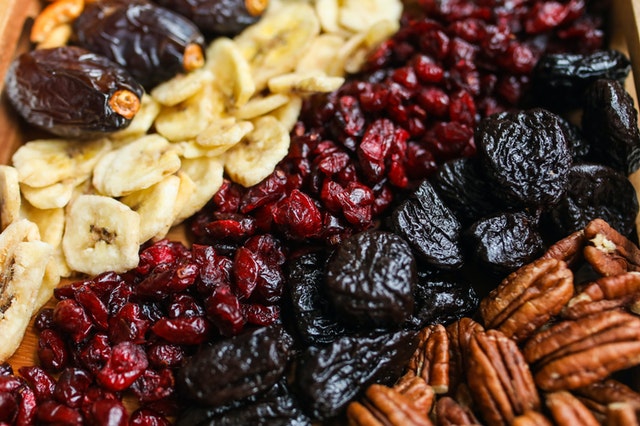
Best food dehydrator consumer reports – Tips & Guides
A food dehydrator is a great investment for anyone who loves spending time in the kitchen. Not only do they make your life easier by preserving your food, but they can also help you create delicious and healthy meals. With so many different models on the market, it can be hard to figure out which one is right for you. We know that everyone’s needs are different, which is why we offer a wide variety of dehydrators- from small personal models perfect for drying herbs or making beef jerky, to large units capable of handling large quantities of food at once. That’s why we’ve put the Best Food Dehydrator Consumer Reports. Keep reading to learn more!
Table of Contents
What is a food dehydrator?
A food dehydrator is a kitchen appliance that is used to remove the water from food. This can be done in order to preserve the food or to make it easier to store or prepare. Dehydrated food often has a longer shelf life than fresh food, and it can also be more nutrient-rich. There are a variety of different food dehydrators on the market, and they vary in terms of size, features, and price. Some people may choose to use an oven or a microwave to dehydrate their food, but a food dehydrator is generally considered to be the best option for this task.
There are a few different ways to dehydrate food. One popular method is to use a food dehydrator. It consists of a series of racks that the food is placed on, and a heating element that dries the food. The dehydration process usually takes around six to eight hours, depending on the type of food and the size of the dehydrator.
Now that you know a little bit about food dehydrators, you might be wondering if this is the right appliance for you. If you are interested in healthy eating, preserving food, or camping, then a food dehydrator is a great option. They are affordable and easy to use, so anyone can enjoy the benefits of dehydration. Head to your local store or online retailer and check out the different food dehydrators on the market today!
Which food dehydrator is the best?
This is a difficult question to answer, as there are many different types and models of food dehydrators on the market. It is important to consider your individual needs and preferences when choosing a food dehydrator. Some factors to consider include the size of the unit, the number of trays, the type of heat source, and whether or not the dehydrator has a timer.
The benefits of owning a food dehydrator
There are many benefits to using a food dehydrator, including:
Preserving foods: Dehydrating foods can help preserve them for longer periods of time. This is especially beneficial for preserving fresh fruits and vegetables that might otherwise go to waste. There are many benefits to using a food dehydrator. One of the main benefits is that it helps to preserve food. This is because it removes the moisture from the food which inhibits the growth of bacteria. This can help to keep your food fresh for longer periods of time.
Reducing food waste: Dehydrating foods can also help reduce food waste, as it allows you to preserve foods that might otherwise go bad.
Saving money: Dehydrating foods can help you save money on groceries, as you will have a longer shelf life for your food items.
Healthy eating: Dehydrating foods can also help you eat healthier, as it allows you to retain more of the nutrients in the food. Dehydrating food can also be a healthy way to eat. This is because it helps to preserve the nutritional value of the food. Dehydrated food is also a great way to snack on something healthy.
Dehydrating food can also help to improve its flavor. When food is dehydrated, it intensifies the flavor. This is because the moisture is removed and it concentrates the flavor.
How to choose the best food dehydrator for your needs
What should I look for when purchasing a best food dehydrator consumer reports?
The first thing you need to consider when purchasing a food dehydrator is the size. You want to make sure that you get one that is the right size for your needs. If you are only going to be using it occasionally, then you may want to go with a smaller model. If you plan on using it frequently, then you will need one that is larger.
Another thing to consider is the features that the dehydrator has. Some of them have temperature controls while others do not. Some also have timers so that you can set it and forget it. You also want to make sure that the dehydration level is adjustable. This will allow you to customize it to your needs.
Finally, you need to consider the price. Choose the dehydrator that fits your budget and your needs.
Now that you know how to choose the best food dehydrator for your needs, let’s take a look at some of the best ones on the market.
How to use a food dehydrator to make healthy, delicious snacks
A food dehydrator is a great way to make healthy, delicious snacks. Dehydrating foods removes the water from them, which helps to preserve them and prevents the growth of bacteria. It also concentrates the flavors and nutrients of the food, making it a healthier alternative to processed snacks. A food dehydrator is a machine that removes the water from food. This can preserve the food and make it last longer. Some people also think that it makes the food taste better.
There are many different types of food dehydrators available on the market. Some are simple machines that have one or two drying trays, while others are more elaborate systems that can hold up to 15 trays. The size of the dehydrator you choose will depend on how much food you plan to dry at once.
When using a food dehydrator, always start with fresh, clean ingredients. Wash and slice your fruits and vegetables accordingly, and make sure they are relatively uniform in size so that they will dry evenly. Putting thicker slices of food into the machine can lead to some areas being over-dried and others still being moist. This can make the overall dehydration process take longer and might produce food that is less palatable. Place the food on the drying trays, making sure there is plenty of space between each piece.
Then set the dehydrator to the appropriate temperature. Most dehydrators have a range of 105-145 degrees Fahrenheit. The time it takes for food to dry will vary depending on the type of food, the humidity level, and the size of the slices, so be sure to check on your food regularly. If you’re not sure how long a particular food should take to dehydrate, consult the manufacturer’s instructions. However, most foods take around 6-8 hours to dry completely.
When the food is done drying, you should let it cool down before eating it. Be careful not to eat any food that has been stored in a food dehydrator for a long time, as it could be dangerous. However, if you’re going to store them for longer than that, it’s best to freeze them.
Once the food is dried, store it in an airtight container in a cool, dark place. It will keep for several months this way. Enjoy your delicious and healthy snacks!
How to clean the food dehydrator
The best way to clean your food dehydrator is to first unplug it and then use a damp cloth to wipe down the exterior. For the interior, you can use a dishwasher safe utensil or a brush to clean off any food residue. Finally, make sure that the dehydrator is completely dry before plugging it back in. Failure to do so may result in a fire hazard.
If you’re looking to clean the trays, you can soak them in hot water and a mild detergent. Be sure to rinse them off thoroughly before using them again. Alternatively, you can place them in the oven on the lowest setting to dry. Just make sure that they are completely cool before handling.
It’s also important to keep the fan blades clean. To do so, use a vacuum cleaner with the hose attachment to remove any food particles. You can also brush them off with a soft-bristled brush. And finally, if there is any build-up of grease or dirt, you can use a degreaser or a cleaning solution specifically made for electronics. Just be sure to follow the manufacturer’s instructions carefully.
Cleaning your best food dehydrator consumer reports is an important part of maintaining it and ensuring that it continues to function properly. By following these simple steps, you can keep your dehydrator clean and running like new.
Recipes for some of our favorite dried fruits and vegetables
Here are a few recipes to get you started:
Recipe 1: Apple Chips
Ingredients: 1 apple, sliced thin and Cinnamon or sugar (optional)
Instructions:
Step 1: Preheat your food dehydrator to 135 degrees Fahrenheit.
Step 2: Place the apple slices on the drying trays, making sure there is plenty of space between each slice.
Step 3: Sprinkle with cinnamon or sugar, if desired.
Step 4: Dehydrate for 6-8 hours, or until dry and crisp
Step 5: Store in an airtight container once they are cool. Enjoy!
Recipe 2: Banana Chips
Ingredients: 1 banana, sliced thin and Cinnamon or sugar (optional)
Instructions:
Step 1: Preheat your food dehydrator to 135 degrees Fahrenheit.
Step 2: Place the banana slices on the drying trays, making sure there is plenty of space between each slice.
Step 3: Sprinkle with cinnamon or sugar, if desired.
Step 4: Dehydrate for 6-8 hours, or until dry and crisp.
Step 5: Store in an airtight container once they are cool. Enjoy!
Recipe 3: Dried Apricots
Ingredients: 1 pound dried apricots. Water and Sugar
Directions:
Step 1: Rinse the apricots and remove any stems or blemishes.
Step 2: Place the apricots in a large pot and cover them with water
Step 3: Bring the water to a boil, then reduce the heat to medium-low and simmer for 30 minutes.
Step 4: Add sugar to taste and cook for another 5 minutes.
Step 5: Drain the apricots and let them cool before eating or storing in an airtight container.
FAQS about the Best Food Dehydrator Consumer Reports
What are some common mistakes people make when dehydrating food?
Some common mistakes people make when dehydrating food include:
Not prepping the food correctly: This includes slicing fruits and vegetables too thick or not evenly, as well as not properly seasoning foods.
Not using the correct temperature: Dehydrating food at too high of a temperature can cause it to cook rather than dehydrate, while dehydrating food at too low of a temperature can result in a slow dehydration process.
Not rotating the trays: It is important to rotate the trays in your food dehydrator so that all of the food items are dried evenly.
Not checking on the food often enough: Checking on your food frequently will help ensure that it is drying evenly and at the correct temperature.
What is the best way to store dehydrated food?
The best way to store dehydrated food is by placing it in an airtight container and storing it in a cool, dark place. Dehydrated food can also be stored in the freezer or refrigerator for extended periods of time.
Can I use a food dehydrator to make jerky?
Yes, you can use a best food dehydrator consumer reports to make jerky. In fact, this is one of the most popular things to make with a food dehydrator. Jerky is a great way to snack on something healthy. It is also a great way to preserve meat.
What are some common foods that can be dehydrated?
Some common foods that can be dehydrated include:
Fruits: Apples, bananas, strawberries, raspberries
Tomatoes, bell peppers, carrots, celery
Meats: Beef, chicken, turkey, ham
Herbs: Basil, thyme, oregano
What are the disadvantages of dehydrating food?
Dehydrated foods have a higher calorie content by weight and can be high in sodium and sugars, depending on the food. In excess, these nutrients can cause weight gain and increase your risk of obesity, heart problems, and diabetes.
What are the risks of using a food dehydrator?
There are few risks associated with using a food dehydrator, but it is important to be aware of them. One risk is that you may not dry your food properly, which could lead to the growth of bacteria or mold. Another risk is that some foods may lose their nutritional value when they are dried. Finally, using a food dehydrator can also lead to an increase in your electricity bill.
>>> See more: How to use • Food Dehydrator FDK 500GCW • Best food dehydrator consumer reports
Conclusion
A food dehydrator is a great investment for anyone who loves to cook and wants to save money on groceries. Not only are they affordable, but they also help you preserve your food so it lasts longer. If you are in the market for a food dehydrator, it is important to do your research and compare different models. The best way to do this is by reading food dehydrator reviews, such as those found on Best Food Dehydrator Consumer Reports. In order to make an informed decision, it is also important to understand what features are important to you and how they can benefit your needs. We hope that our guide has helped you better understand the different types of food dehydrators available and which one might be right for you.
Read more:



